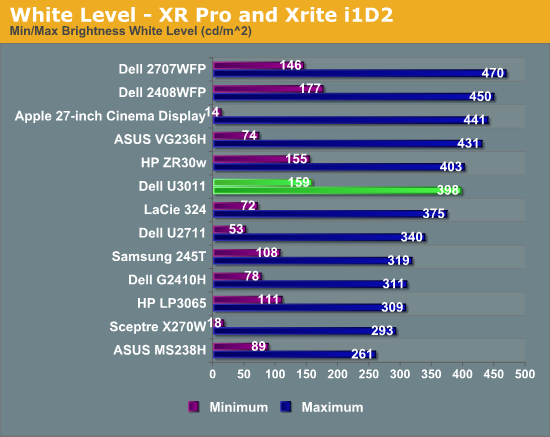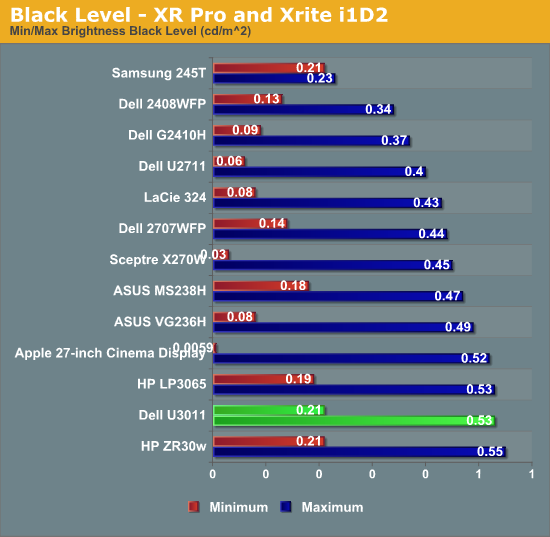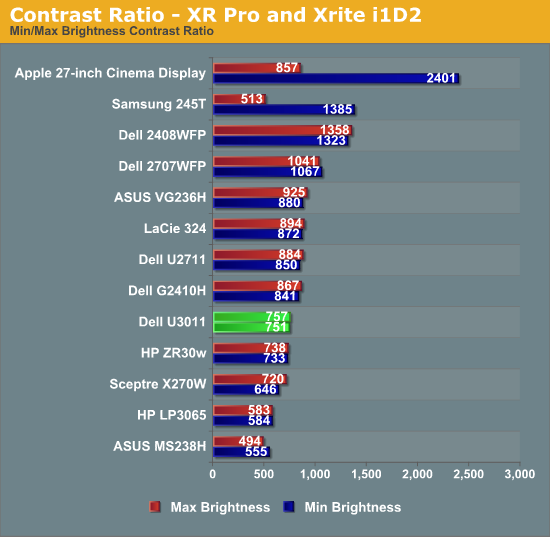Dell U3011 Review: Dell's New 30-inch Flagship
by Brian Klug on January 13, 2011 9:17 PM ESTBrightness and Contrast
For brightness we display white and black levels at maximum and minimum brightness as allowed by the OSD, and divide the two to get contrast. We use the same colorimeter described earlier. In this case, an Xrite i1D2 with ColorEyes Display Pro. For the U3011, dynamic contrast is turned off, contrast is set to maximum on the OSD, and the brightness control is varied across its possible dynamic range.



The brightness dynamic range on the U3011 isn't really amazing. In fact, it was a challenge to get the display to 100 nits for calibration (it required changing contrast and carefully balancing brightness and contrast controls on the OSD). One look at the contrast ratio plot however, and it's obvious what Dell did here - sacrifice dynamic range control for luminance but in so doing keep contrast extremely stable across that range of brightnesses. It's a tradeoff which actually makes a lot of sense, even if it isn't readily apparent when you're playing with the display, especially because the contrast OSD control visually makes a much larger difference than brightness which actually controls the CCFL power. I took a lot more data, but between max brightness and min brightness, contrast is pretty steady at around 750.
It's a bit unfortunate that the IPS in the U3011 isn't a bit more contrasty, especially when advertised is around 1000:1 with dynamic contrast off. Still, not bad.










123 Comments
View All Comments
cjl - Friday, January 14, 2011 - link
1) All LCDs these days use overdrive. Whether advertised or not. It's the only way that an LCD can get a response time better than roughly 15-20ms.2) This is an IPS panel. The Alienware is a TN. TN panels are able to do 120Hz better than IPS. That's one reason why this isn't 120Hz.
3) 120Hz 2560x1600 is not doable with any current display connector other than possibly DisplayPort. Dual link DVI is only able to drive it at 60Hz, and HDMI can't even get up to native.
MeanBruce - Friday, January 14, 2011 - link
Ordered an Asus 6870 DirectCU from Newegg, it has 2 DisplayPorts regular not mini. Will I have to use both to run 120Hz 2560x1600? On this or HPs 30inch?cjl - Friday, January 14, 2011 - link
Neither is capable of 120Hz operation, so it doesn't matter how many connectors you hook up, it will never run faster than 60Hz. If someone were to release a 120Hz 2560x1600 panel, I believe that the newest DisplayPort standard could drive it with one connector. Other than that, no existing connector could pull it off.DanNeely - Saturday, January 15, 2011 - link
HDMI 1.3/1.4 have the same bandwidth as DVI, so they could drive a 2560x1600x60hz display.MeanBruce - Friday, January 14, 2011 - link
I gitcha ;) and agree, Dell should have put so much more into this panel, or should offer another 30inch with full RBG and a remote for switching inputs and volume tied to the Soundbar.Breit - Friday, January 14, 2011 - link
What about the 10Bit color support? Where you able to test it during your review? I personally own a Dell 3011 but have never seen any option to enable it on my ATI/AMD GPUs (neither 5870 nor 6970) even through different connection options (DP, DVI, HDMI). It must be a professional-only feature, at least for the red GPU camp?! Maybe this is the way to gain access to a calibrated Delta-E below 1.0 ... ;)Toshio - Friday, January 14, 2011 - link
For those interested in this monitor for gaming, here's a comparison of Dell 3007WFP-HC and 3008WFP:http://www.digitalversus.com/duels.php?ty=6&ma...
Unfortunately, none available anymore at dell.com :(
I personally own the 3007WFP-HC basically for gaming and I can tell you lag is not noticeable at all (just as it was with the original 3007WFP).
I'm not sure what method was used to measure lag in the U3011, but if it's similar to the older 3007WFP-HD I think we got a winner here.
As somebody else said, we would like to see this monitor's specs compared to previous Dell models. The ones I've personally tried are:
2408WFP (first revision) - Horrible Lag, no good for gaming at all. Average lag accordign to digitalversus: 69ms
3007WFP - Unnoticeable lag, good response for FPS gaming.
3007WFP-HC - same as previous.
3007WFP - I haven't tried this one but most reviews show terrible input lag.
What you'll find as common ground is that lag-free monitors don't have DSP (thus no OSD) and only DVI inputs, while the ones with more inputs and features (HDMI, OSD, monitor scaling) have noticeable lag. If Dell managed to cut lag while giving good features we surely have a good alternative in the U3011.
mac2j - Friday, January 14, 2011 - link
Should have been RGBLEDShould have been 120Hz which is totally supported by the current generation of graphics cards through displayport 1.2 or HDMI 1.4
Ryan Smith - Friday, January 14, 2011 - link
HDMI: No. I'll go light on the technical details, but it doesn't have enough bandwidth to drive 2560 at 120Hz (it has about half as much as necessary). Frame packing actually makes this really ugly - for 3D as defined by HDMI it only has enough bandwidth for 1080P 24Hz.DP1.2: Yes. However this monitor has been out for a few months, which is to say that it came out before anyone had a DP1.2 display controller ready. DP1.2 displays won't be out until later this year.
AnnonymousCoward - Saturday, January 15, 2011 - link
HDMI: yesDP: yes
DVI: yes
VGA: yes
No one said it has to be at 2560. In an FPS, 1680x1050@120Hz is better than 2560x1600@60Hz.